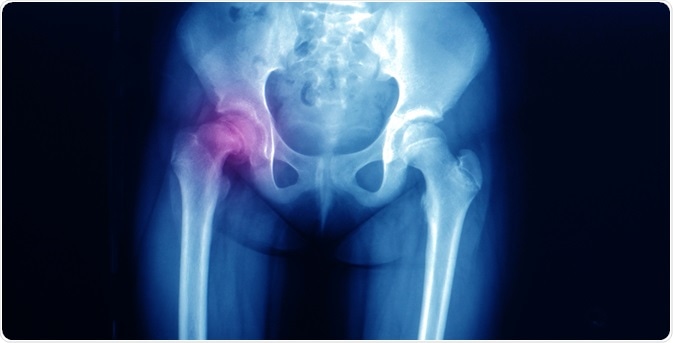Slipped Capital Femoral Epiphysis (SCFE) is a condition with symptoms that vary in severity. Both stable and unstable SCFE are heralded by nonspecific pain in the groin and hip, or, more confusingly, in the knee or thigh, for as much as several weeks prior to the actual slippage. Early diagnosis is important in order to improve the outcome.
 Image Credit: Yok_onepiece / Shutterstock.com
Image Credit: Yok_onepiece / Shutterstock.com
However, the vague symptoms in the stable type, which makes up the majority of cases, mean that it is often diagnosed late, after the onset of deformity and damage to the articular cartilage and the joint structure.
Early diagnosis requires that healthcare providers be aware of this condition in the adolescent and pre-teen age group. The occurrence of referred pain or the absence of discomfort in some cases may lead to missing the condition. The presence of risk factors should heighten awareness of this condition, but their absence should never lead to its dismissal.
The risk factors include:
- Obesity
- Endocrine disorders such as hypothyroidism or pituitary dysfunction
Mild stable SCFE
These patients may occasionally be completely asymptomatic with respect to the hip. Most have chronic symptoms such as:
- Intermittent groin or hip pain, or pain in the medial thigh, which is exacerbated by activity, and may lead to the appearance of a limp after exertion
- Pain in the knee in 15-50% of cases, referred from the hip and may be the only symptom
- Drehmann’s sign is positive, meaning the hip remains in external rotation and abduction when released from passive flexion in a supine position
- External rotation of the leg is obvious when the child walks.
- The affected leg is shorter than the other one and may be thinner because of thigh muscle atrophy
Severe or unstable SCFE
Patients with acute SCFE may complain of symptoms such as a chronic limp for 1-3 weeks, or a long-term sharp or aching pain in the anterior hip, groin, or thigh. This may be followed by:
- Sudden pain with or without a history of previous trauma
- Being unable to put any weight on the affected hip
- External rotation of the affected leg
- The affected limb appears shorter than the other one
- The hip cannot be rotated internally or abducted without severe pain
- Drehmann’s sign is positive
Patients with acute-on-chronic SCFE have symptoms such as limping and pain in the hip for a few months before the acute onset of severe pain and inability to bear weight on the involved leg.
Physical examination
A physical examination follows a general history to assess the child’s health and any previous medical conditions. The onset of the condition is also traced as far back as possible. The examination moves the hip through its complete range of motion to evaluate:
- Stiffness, restriction of movement and pain with movement
- Limitation of internal rotation of the hip which is the most sensitive and specific sign
- Restricted hip flexion on passive movement
- Guarding and spasms of the muscle around the hip
- The gait which is usually abnormal in this condition
There is, however, no diagnostic finding specific for this condition.
Imaging
Biplanar X-rays are the primary study tool for this condition as they provide an accurate picture of the state of the bone. Supine anteroposterior and frog-leg lateral (Lauenstein) views are often requested to identify the pathology.
The pre-slip condition is signaled by a slight widening of the growth plate.
Early signs of slippage include joint capsule swelling, the presence of widening of the physis, and decalcification of the edge of the femoral shaft adjacent to the epiphysis.
A mild slippage is present when the femoral neck extends right up to the edge of the epiphysis.
The femoral head is displaced posteriorly with respect to the femoral neck.
The role of ultrasound is limited and shows the presence of a restricted effusion as well as displacement of the metaphysis before the slip occurs. MRI is also able to show the characteristic growth plate abnormalities before the epiphyseal slippage. CT scanning is indicated for the diagnosis of more complex deformities.
References
Further Reading
Last Updated: Feb 18, 2021